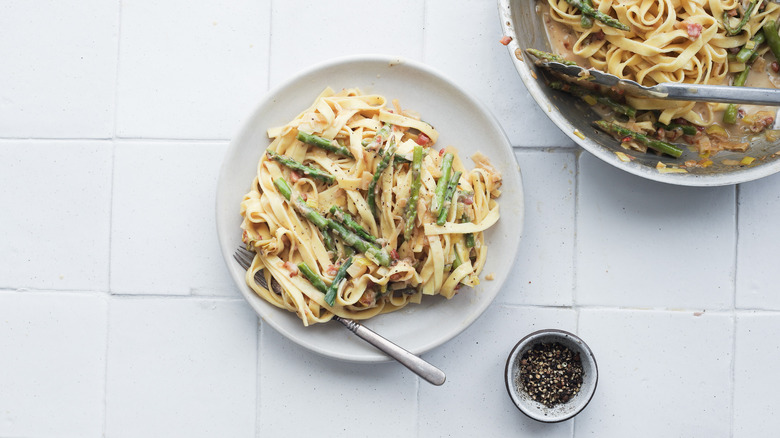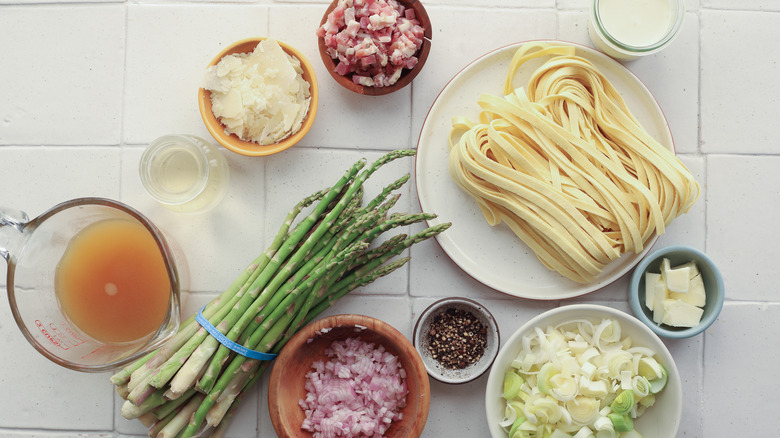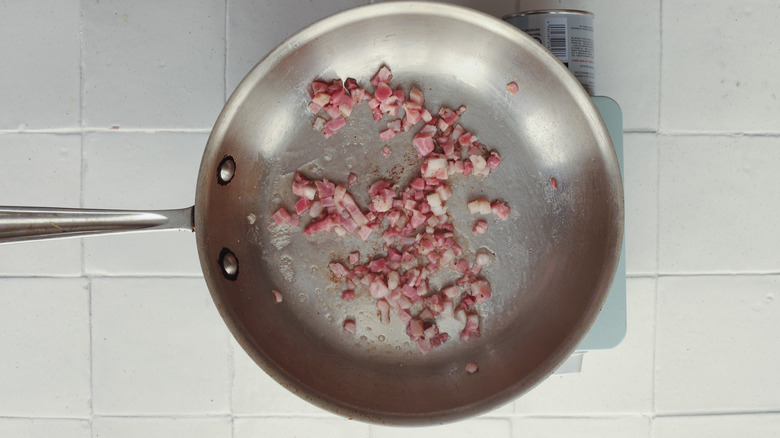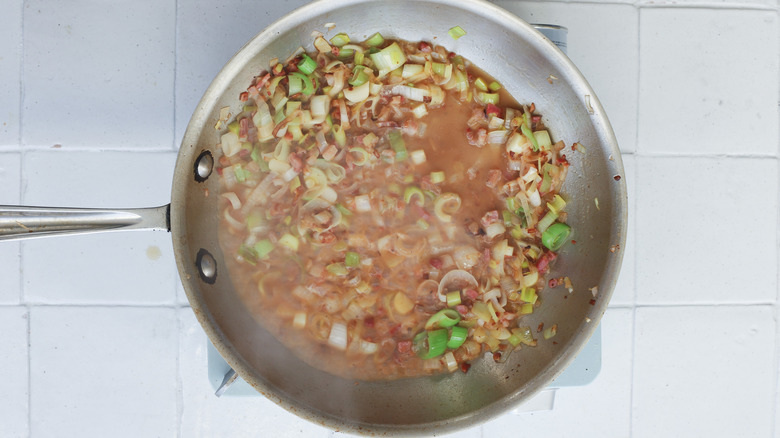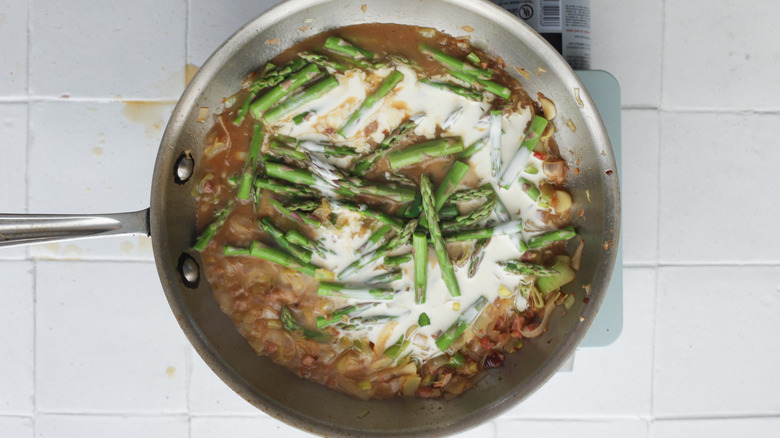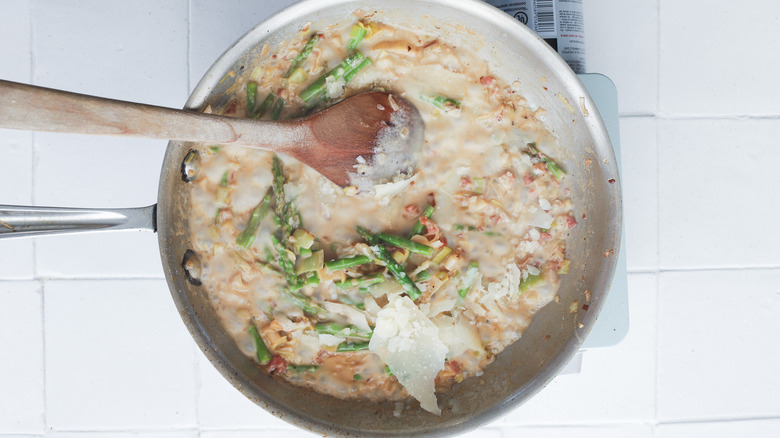Asparagus, Leek, And Pancetta Pasta Recipe
Asparagus is a delightful vegetable that can be eaten well beyond the confines of its season (though spring asparagus is almost always better tasting). Even if you consider yourself a bonafide asparagus lover, after a while, you're bound to get sick of eating it sauteed in butter over and over again.
Looking for variety? For a great asparagus recipe, try this asparagus and pancetta pasta. Even though it sounds fancy, it's super easy to whip up and impress guests. The asparagus gives it a fresh pop, enhancing the dish. This goes great with the creamy sauce and the salty bits of pancetta.
It's the kind of dish you'd want to make for friends over or a cozy date night. And if you're looking for a tasty springtime meal, this is it. In short, it's a cool mix of tasty Italian vibes, perfect for anyone who loves a good pasta plate.
Grab the ingredients for asparagus pasta
The main ingredients for this asparagus pasta are going to be fresh asparagus spears, diced pancetta, and leeks. When choosing pancetta, you can find it pre-cut at the supermarket, or buy a chunk and cut it yourself. The leeks should be cut from the green and white parts of the vegetable only — save the dark green bits for a stock. These will form the bulk of the dish, along with the pasta itself. Everything else is a flavoring or sauce component.
For this recipe, we used fresh pasta, as opposed to dried, though dried pasta will still work (just adjust the cooking time). Finely diced shallots are a great way to start the building blocks of flavor in the dish, especially when deglazed in the pan with white wine. The sauce is made of cream, which adds a nice richness to the dish and is offset by freshly cracked ground pepper (don't substitute with pre-ground).
Brown the pancetta
Pancetta, like its cousin bacon, is typically browned or rendered before eating. Technically, it is edible when "raw", but this ingredient crisps up beautifully. Imagine golden brown chunks of savory pork, succulent on the inside and crispy on the outside. Proper browning will ensure the pancetta retains its texture even once the liquid ingredients are added to the pan.
To brown the pancetta, first, melt a tablespoon of butter in the pan (this could be subbed for olive or vegetable oil if need be). Add the pancetta and cook over medium heat. Be careful not to overcook or burn the pancetta, as once you've gone too far you can't go back and the meat will continue to cook a few degrees even when the other ingredients are added.
Add aromatics and deglaze
Once you've prepped your leeks and shallot, melt the remaining butter in the pan. Butter not only adds a rich, creamy flavor but also helps in softening the vegetables faster, thanks to its fat content. Mix the leeks and shallot in the butter, ensuring they're well coated. Let them cook over medium heat. As they cook, you'll notice the vegetables releasing their aromas and turning translucent, a sign that they're softening. This process should take about 3 minutes, but it's crucial not to rush it, as this base layer of flavor is essential for the final dish.
After your aromatics are softened, it's time to add the white wine. Pouring wine into a pan that has sautéed ingredients is called "deglazing." This process lifts the browned bits from the bottom of the pan, incorporating all that flavor into the wine. Use a good quality white wine, one that you'd enjoy drinking. As the wine simmers, its sharp alcoholic edge will evaporate, leaving behind a rich and nuanced taste. Cook until the wine has reduced significantly. You want to end up with about two tablespoons of liquid. This concentrated wine reduction will infuse the dish with depth and acidity, balancing out the richness of the other ingredients.
Add the asparagus and broth
This next step will build the main sauce of the pasta. Pour the cream and broth into the pain, then fold in the asparagus. Wait for the mixture to return to a boil, then reduce the heat so it hits a nice steady simmer. While the sauce is thickening, it's also cooking the asparagus to save a step and a separate pan. If you have not already cooked the pasta, drop it into some salted boiling water after the asparagus has cooked for about 2 minutes.
Finish the sauce
At this point, the asparagus should be cooked and the sauce thickened. To test if it is thick enough, it should be able to coat the back of a spoon. Remove the pan from heat, add in the cheese, and season the sauce with salt and pepper. Fold in the cooked pasta and serve with additional cheese, if desired.
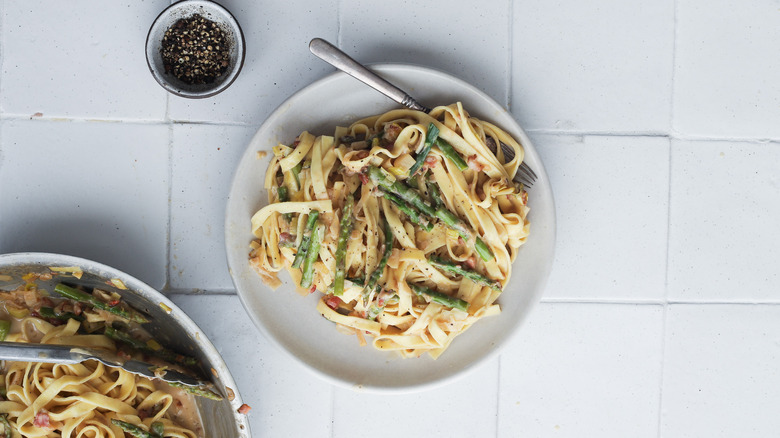
- 12 ounces linguine
- 4 ounces diced pancetta
- 2 tablespoons cold unsalted butter, cubed
- 1 1/2 cups thinly sliced leeks
- 1 shallot, finely chopped
- 1/3 cup white wine
- 1/2 cup chicken broth
- 1/2 cup heavy cream
- 1 bunch asparagus, cut into 2-inch chunks
- 2 teaspoons ground black pepper
- 3/4 cup grated parmesan cheese, plus more for serving
- Cook pasta per package directions. Set aside.
- In a medium skillet over medium heat, add pancetta and 1 tablespoon butter. Cook until pancetta is rendered and just beginning to crisp.
- Add leeks, shallot, and remaining butter. Cook until softened and translucent, about 3 minutes.
- Pour white wine into pan and cook until wine is reduced to about two tablespoons.
- Add broth, cream, and asparagus to the pan. Simmer until asparagus is tender and sauce is thickened, about 5 minutes.
- Remove pan from heat and stir in pepper and cheese.
- Taste and adjust seasoning before adding cooked pasta to the pan.
- Serve with additional cheese, if desired.
| Calories per Serving | 1,014 |
| Total Fat | 47.8 g |
| Saturated Fat | 24.7 g |
| Trans Fat | 0.5 g |
| Cholesterol | 116.6 mg |
| Total Carbohydrates | 102.7 g |
| Dietary Fiber | 7.0 g |
| Total Sugars | 10.0 g |
| Sodium | 812.7 mg |
| Protein | 38.4 g |
